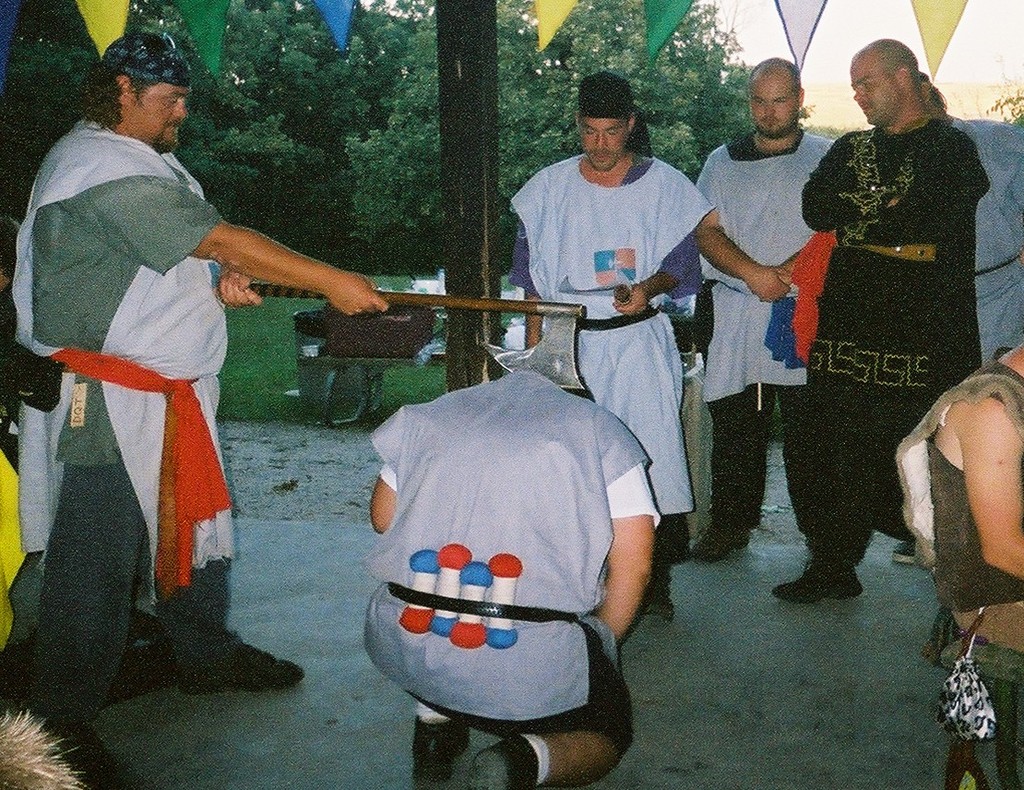Ever wondered what larpers really do? It's not just about dressing up and pretending to be a knight or wizard. Larping, short for Live Action Role-Play, is a vibrant community where imagination meets reality. It’s a world where people step into the shoes of their favorite characters, creating unforgettable experiences. So, let’s dive in and unravel the mystery behind these modern-day adventurers!
Larpers might sound like a niche group, but they’re more common than you think. You’ve probably seen them at conventions, parks, or even in your neighborhood, dressed in armor or wielding foam swords. But there’s so much more to their world than just costumes. This activity taps into creativity, storytelling, and even personal growth. It’s not just a hobby; it’s a lifestyle.
As we explore what larpers are, we’ll uncover the history, the benefits, the challenges, and the misconceptions surrounding this fascinating hobby. Whether you’re curious about joining or just want to understand the phenomenon, this article has got you covered. Let’s get started!
Read also:Prince Raymond King The Untold Story Yoursquove Been Missing
What Exactly Are Larpers?
So, what exactly are larpers? Simply put, they’re individuals who participate in live action role-playing games. These games involve acting out scenarios as characters, often in fantastical or historical settings. Think of it as theater meets gaming, but instead of just sitting on a couch, you’re fully immersed in the story.
Larpers can range from casual enthusiasts to dedicated players who spend months crafting their costumes and backstories. The beauty of larping lies in its inclusivity—anyone can join, regardless of age, gender, or background. It’s a space where imagination knows no bounds, and everyone is welcome to play their part.
Types of Larp Games
Not all larp games are the same. There are several types, each catering to different interests and preferences. Here’s a quick rundown:
- Boffer Larp: This type involves physical combat using padded weapons. It’s perfect for those who love the thrill of battle.
- Theater-Style Larp: Focuses more on storytelling and character interaction, often without physical combat. Ideal for drama enthusiasts.
- Parlor Larp: Played in smaller settings, usually indoors, with minimal props. Great for intimate storytelling experiences.
- Themed Larp: Set in specific worlds, like fantasy, sci-fi, or historical settings. Think Game of Thrones or Star Wars.
No matter which type you choose, there’s something for everyone in the world of larping.
History of Larping
The roots of larping can be traced back to tabletop role-playing games like Dungeons & Dragons. In the 1970s and 80s, gamers began taking their adventures off the table and into real-life settings. What started as small gatherings grew into a global phenomenon, with events drawing thousands of participants.
Today, larping has evolved into a complex and diverse activity, with communities in almost every corner of the world. From large-scale festivals to local meetups, the larping scene continues to grow, attracting new players and expanding its reach.
Read also:Spotlight On Juilliard School Notable Alumni Who Shaped The World
The Evolution of Larping
Over the years, larping has undergone significant changes. Advances in technology have allowed for more immersive experiences, with players using apps and special effects to enhance their games. Themes have also expanded beyond traditional fantasy, incorporating modern and futuristic settings.
Here’s a look at some key milestones in the evolution of larping:
- 1980s: The birth of modern larping, with the first organized events.
- 1990s: Increased popularity, leading to larger events and international exchanges.
- 2000s: Introduction of new themes and technologies, broadening the scope of larping.
- 2010s-present: Global expansion and mainstream recognition, with larping appearing in media and pop culture.
As the world becomes more connected, the future of larping looks brighter than ever.
Why Do People Become Larpers?
There are countless reasons why people choose to become larpers. For some, it’s about escapism—a chance to leave the real world behind and step into a realm of fantasy. For others, it’s about socializing, meeting new people, and building lasting friendships. And then there are those who see larping as a form of personal expression, a way to explore different identities and perspectives.
Here are some of the most common reasons people become larpers:
- Creativity: Larping allows players to unleash their imagination and create unique stories.
- Social Interaction: It’s a great way to meet like-minded individuals and expand your social circle.
- Personal Growth: Playing different characters can help players develop empathy, communication skills, and confidence.
- Adventure: Larping offers a sense of adventure and excitement that’s hard to find in everyday life.
Whatever the reason, one thing is clear: larping provides a unique and rewarding experience for those who participate.
What Makes Larping So Appealing?
Beyond the obvious fun factor, larping offers a range of benefits that make it an appealing hobby. It’s not just about playing pretend; it’s about creating meaningful experiences and connections. Many players report feeling more confident, creative, and socially engaged after participating in larp events.
Studies have even shown that larping can have positive effects on mental health, helping players reduce stress and improve their overall well-being. It’s a hobby that truly enriches lives, offering something for everyone.
Common Misconceptions About Larpers
Despite its growing popularity, larping still faces its fair share of misconceptions. Some people view larpers as quirky or eccentric, dismissing their hobby as childish or irrelevant. But nothing could be further from the truth. Larpers are a diverse group, ranging from students to professionals, all united by their love for storytelling and adventure.
Here are some common misconceptions about larpers:
- It’s Only for Kids: Larping is enjoyed by people of all ages, from teens to seniors.
- It’s All About Fighting: While combat is a part of some games, many larp events focus on storytelling and character interaction.
- It’s Expensive: While costumes and props can be costly, many players start with basic setups and gradually build their collections.
- It’s Not Serious: Larping takes dedication and effort, with players investing time and energy into their characters and stories.
By breaking down these myths, we can better appreciate the depth and complexity of larping as a hobby.
How to Overcome Stereotypes
Changing perceptions takes time, but larpers are doing their part to combat stereotypes. By hosting public events, sharing their experiences on social media, and engaging with the broader community, they’re helping to demystify larping and show its true value.
Here are a few ways larpers are breaking down barriers:
- Education: Hosting workshops and talks to explain the hobby to outsiders.
- Collaboration: Partnering with other creative communities to showcase larping’s artistic side.
- Visibility: Appearing in media and pop culture to increase awareness and understanding.
As more people learn about larping, the stigma surrounding it continues to fade.
Benefits of Being a Larper
Being a larper comes with a host of benefits that go beyond just having fun. From improving social skills to boosting creativity, larping offers a wealth of advantages for players. It’s a hobby that enriches lives, fostering personal growth and community engagement.
Here are some of the key benefits of being a larper:
- Enhanced Creativity: Larping encourages players to think outside the box and come up with innovative solutions to challenges.
- Improved Communication: Acting as a character requires strong communication skills, helping players become better at expressing themselves.
- Increased Confidence: Stepping into the shoes of a character can help players feel more confident in their own lives.
- Stress Relief: Larping provides a much-needed escape from the stresses of everyday life, allowing players to recharge and relax.
These benefits make larping a valuable hobby for anyone looking to improve their skills and well-being.
Long-Term Impact of Larping
For many players, larping has a lasting impact on their lives. It’s not just a hobby; it’s a journey of self-discovery and growth. Many larpers report feeling more connected to others, more empathetic, and more fulfilled as a result of their participation.
Here’s how larping can make a difference in the long run:
- Building Resilience: Overcoming in-game challenges helps players develop resilience and problem-solving skills.
- Fostering Community: Larping creates strong bonds between players, forming supportive and inclusive communities.
- Encouraging Lifelong Learning: Players are constantly learning new skills, from costume-making to storytelling, keeping their minds sharp.
The impact of larping extends far beyond the game itself, enriching players’ lives in countless ways.
Challenges Faced by Larpers
While larping is a rewarding hobby, it’s not without its challenges. From logistical issues to social pressures, players face a variety of obstacles that can make the experience more difficult. Understanding these challenges is key to overcoming them and enjoying the full benefits of larping.
Here are some common challenges faced by larpers:
- Time Commitment: Larping can be time-intensive, requiring players to invest hours in preparation and participation.
- Cost: High-quality costumes and props can be expensive, making it difficult for some players to fully engage.
- Social Stigma: As mentioned earlier, larping still carries a certain stigma, which can be discouraging for new players.
- Physical Demands: Some larp games involve physical activity, which may not be suitable for everyone.
Despite these challenges, many larpers find the rewards far outweigh the difficulties.
How to Overcome These Challenges
Overcoming the challenges of larping requires creativity, flexibility, and a willingness to adapt. Here are a few strategies players can use to make the most of their larping experience:
- Start Small: Begin with smaller events or parlor larps to ease into the hobby.
- DIY Costumes: Create your own costumes and props to save money and add a personal touch.
- Find a Community: Join local groups or online forums to connect with other players and share tips.
- Set Realistic Goals: Focus on what you enjoy most about larping, whether it’s storytelling, combat, or socializing.
By addressing these challenges head-on, players can create a more enjoyable and fulfilling larping experience.
How to Get Started as a Larper
Ready to dive into the world of larping? Getting started is easier than you might think. Here’s a step-by-step guide to help you on your journey:
- Research: Look up local larp events and groups to find one that suits your interests.
- Create a Character: Develop a backstory and personality for your character, keeping in mind the game’s setting and rules.
- Gather Gear: Start with basic costumes and props, gradually building your collection as you become more involved.
- Join a Group: Attend your first event and meet fellow players. Don’t be afraid to ask questions or seek advice.
Remember, larping is all about having fun and exploring your creativity. There’s no right or wrong way to play, so don’t be afraid to experiment and find what works best for you.
Tips for New Larpers
Here


